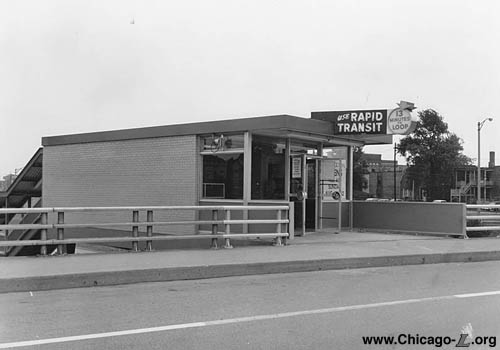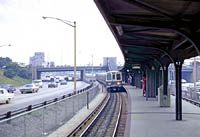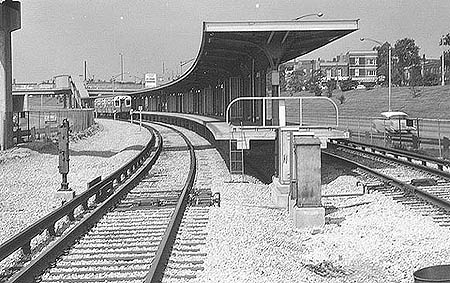
This view looking southeast
at the Kostner station house in August 1962, shortly after
opening. The Kostner station followed the design of the
Congress stations built five years earlier, but scaled the
design down to a smaller floor plan, consistent with the
modest number of passengers that were expected at this
station. The paper sign in the front window to the right of
the doors reads: "THIS
STATION OPENS 4:30AM SUNDAY AUG. 5,
1962".
(CTA Photo)
|
Kostner
(4400W/530S)
Kostner Avenue and the
Eisenhower Expressway, West Garfield Park
Service
Notes:

|
West-Northwest
Route: Congress
|
Quick Facts:
Address: 530 S. Kostner
Avenue
Established: August 5, 1962
Original Line: West-Northwest Route, Congress branch
Previous Names: n/a
|
Skip-Stop Type:
|

|
Station
|
Rebuilt: n/a
Status: Abandoned
History:
Every station on the Congress
Line was almost exactly the same, except Kostner, which had one
big difference: it was opened after the rest of the line.
Kostner station was not part of the original plans for the
Congress Line.
Stations had been planned roughly every half mile east of Kedzie
and spaced at approximately one mile intervals west of Kedzie
where population densities were more diffuse. However, most stations
had two entrances, spaced about a quarter miles apart, bringing a
larger number of people within walking distance of a station
entrance. Stations were planned at Pulaski
and Cicero, with an auxiliary
entrance at the west end of Pulaski
at Keeler Avenue. On the adjacent Garfield
Park Line that the Congress
Line was replacing there had been two stations between Pulaski
and Cicero: Kilbourn
and Tripp. The Keeler entrance to
Pulaski was reasonably close from
where the Tripp station had been (about
a half-block), but there really was no direct replacement for
Kilbourn station (other than walking
three blocks east or west to Keeler or Cicero,
respectively).
Residents wanted an intermediate station at Kostner Avenue --
exactly halfway between Pulaski Road and Cicero Avenue, although only
two blocks from the Keeler entrance to Pulaski
-- but city and CTA planners
and engineers resisted. The wider spacing of the stations with the
provision of multiple entrances was intentional on the part of the
city and CTA , who designed the
line to provide faster travel times with fewer stops. Now that the
surface and rapid transit systems were unified under the
CTA , close "L" station spacing
to compete with surface lines became redundant.
CTA planners preferred that
passengers be "combination riders", as period advertising put it --
to use buses for local, short-haul trips and rapid transit for longer
journeys. Wider station spacing and faster train speeds made this
type of mode split more attractive.
Local residents were not interested in
CTA planners' broader goals of
efficiency and system productivity and continued to press for an
intermediate station. Community pressure led to the passage of a city
council ordinance on July 26, 1955 requiring that an intermediate
station be built, but the city Department of Public Works and the
CTA dragged their feet on
building the station. CTA's ridership projections showed that the station would never attract
sufficient ridership to justify its construction. In addition, the
station would require additional operating equipment and funding and
discourage commuters living to the west of Kostner Avenue because of
additional running times resulting from an added station stop.
Residents tried to negotiate, saying they didn't demand an
extravagant station and would settle merely for wooden boarding
platforms with stairs up to the Kostner Avenue overpass. In reality,
it's doubtful the city or CTA would have agreed to this, both due to operational issues such as
fare control and due to a desire not to blemish the sheen of the
system's new showpiece line with utilitarian wooden platforms. By
spring 1960, local residents were losing patience and threatened a
lawsuit against the Chicago Department of Public Works (under whose
auspices the construction of the Congress
Line actually fell).
|

Kostner's curved platform
and stairway connection to its station house are evident in
this view looking west on August 7, 1967 as a
Logan
Square-bound
Milwaukee-Congress train of 2000-series
railcars enters the station. Otherwise, Kostner was a
typical Congress
Line station. For a
larger view, click here.
(Photo by Thomas H. Desnoyers,
courtesy of the Krambles-Peterson Archive)
|
By 1961, the city and
CTA capitulated and agreed to
add a Kostner station. Construction of the station began in late 1961
and cost $750,000, funded by the City of Chicago. An
intergovernmental agreement was signed between the city and the
CTA whereby the
CTA would perform track work
and install signals and power distribution facilities and the city
would build the station itself. Since the Congress
Line was already in operation and needed to remain in operation
while a new island platform was built between the tracks the
CTA first built two temporary
bypass, or "shoofly", tracks around the station site. The shoofly
tracks were used from November 2, 1961 to July 8, 1962 while a
contractor chosen by the city under a competitively bid contract
constructed the station facility.
The station was dedicated at a special ceremony held on August 3,
1962 attended by Mayor Richard J. Daley, Public Works Commissioner
(and future CTA chairman)
George L. DeMent, 30th Ward Alderman Daniel J. Ronan, and
CTA Chairman Virgil E.
Gunlock. The station opened to the public at 4:30am, Sunday, August
5, 1962.
The Kostner station is nearly identical to every other station
built on the Congress
Line, including an island platform and a small station house on
Kostner's overpass. The station house is smaller than most Congress
stations, however, due to the relatively low patronage the Kostner
station was expected to attract. Unlike the long, enclosed, sloping
ramps that connected the station houses to the platforms at most
Congress stations,
Kostner instead had stairs.
The Kostner station house, located on the east side of the Kostner
Avenue expressway overpass, is 32 feet long and 17 feet wide (smaller
than the 42 feet long and 21 feet wide typical Congress
stations). Continuing the pattern of rotating decorative colors, the
exterior walls were a combination of light gray blazed brick and
structural glass blocks. The station's storefront-type entrance was
constructed of aluminum panels, polished plate glass windows, and two
aluminum framed plate glass doors with the signature Congress
Line cast CTA logo door
handles.
The interior of the station house was finished in light gray
glazed tile with modern florescent lighting. The smaller dimensions
of the station house translated into much more modest fare controls
than the other Congress
stations. There was a one-position stainless steel agent's booth (as
opposed to the two-position booths at other Congress
stations), an agent-controlled turnstile, and one exit turnstile.
There was no exit rotogate, no coin-operated turnstile (although
there was space to install one later, if desired), and no complex
system of rolling gates to close off the agent-controlled turnstile
during periods of pay-on-train.
The island platform is 600 feet long, typical of Congress
Line stations. What is not typical of how severely curved
Kostner's platform is, a result of the existing track profile that
was never designed to accommodate a station platform. Line-of-sight
for conductors was a problem at the station, aided mostly by the
addition of a series of mirrors that allowed the conductors to see
the entire side of the train consist. The platform was covered with a
canopy for its entire length. The canopy is supported by a row of
structural steel columns that split into gently curving angled to
support the canopy roof. Eight windbreaks, each 15 feet long and six
feet high, were spaced along the platform to provide additional
shelter. Clay tiles were inlaid along the platform edge to emphasize
it for safety purposes.
The insufficient demand for the Kostner station quickly became
evident, earning Kostner a place among the shortest-lived of Chicago
rapid transit stations. The station's annual ridership never reached
more than just over 258,000, achieved in 1967. Thereafter, ridership
began to decline, falling off to 137,791 -- just over half its
all-time ridership high -- in 1972, its last full year of
operation.
When CTA began facing
severe financial hardship in the early 1970s, Kostner became an easy
choice to close for economization. Kostner station closed Sunday,
September 2, 1973, in the same service revision that closed California
and Central on the Congress
Line, Dorchester on the Jackson
Park branch, State/Van
Buren in the Loop,
State/59th on the Englewood
branch, and Isabella on the Evanston
Line. Today, the Kostner station sits abandoned, its station
house entrance secured with a plywood covering and high chainlink
fencing.

A 6000-series
train stops at the Kostner island platform, looking west in
1962. The station house is up ahead on the overpass;
passengers reached the platform through a steep set of
stairs, one of the few Congress stations to have such
access. For a larger view, click here.
(Photo from CTA Collection)
|
(Thanks to Alan
Follett for providing some information.)





